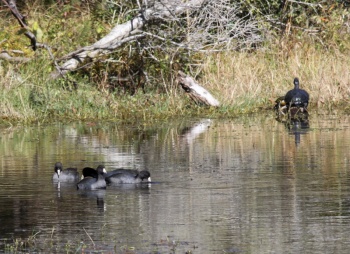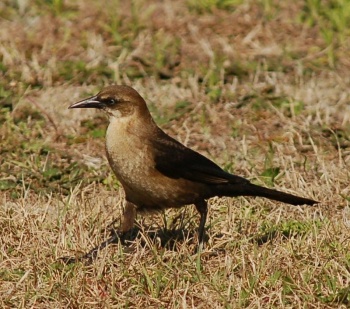
Photo © by tetoneon
Hatteras, Outerbanks, North Carolina May 6, 2011
Overview
The Outer Banks in Eastern North Carolina is probably one of the best places in North Carolina to bird. The extreme eastern point, Cape Hatteras, is noteworthy for seabirds, with a mix of cold-water and warm-water species occurring. But the Banks, as a whole, comprise much more. They are a combination of barrier islands in 3 different counties, Currituck, Dare, and Hyde, and represent a wide range of habitat and associated species of birds and wildlife.
Birds
Notable Species
When thinking about the birds that are on the Outer Banks, it’s only natural a person’s first reaction is the likes of shorebirds, and rightfully so. After all, the Banks are situated between the Atlantic Ocean on their eastern side and a number of sounds, rivers, and waterways on their western side. But they also boast more than that, when it comes to birds. Some of the more reported birds to eBird, along with shorebirds, could include these. Snow Goose, Double-crested Cormorant, Laughing Gull, Tree Swallow, Bonaparte’s Gull, Redhead, Red-winged Blackbird, and Common Grackle.
Rarities

Photo © by tetoneon
Outer Banks, North Carolina November, 2014
Species less likely to be seen on the Banks might include the Scarlet Tanager, Western Tanager, Dickcissel, Gray Kingbird, European Storm Petrel, Glossy Ibis, Black-throated Gray Warbler, Townsend's Warbler, Canada Warbler, Saltmarsh Sparrow, Dark-eyed Junco, Indigo Bunting, Black-throated Green Warbler, American Goldfinch, Orange-crowned Warbler, American Coot, Scarlet Tanager, and Painted Bunting.
Check-list
Birds you can see here include:

Photo © by Terry O'Nolley
Kill Devil Hills, Outer Banks, North Carolina, April 2006
Double-crested Cormorant, Laughing Gull, Red-breasted Merganser, White Ibis, Royal Tern, Dunlin, Sanderling, Black Scoter, Brown Pelican, Black Tern, Brown-headed Cowbird, Ring-billed Gull, Tundra Swan, American Robin, Lesser Scaup, Redhead, Boat-tailed Grackle, Snow Goose, Green-winged Teal, Virginia Rail, Purple Sandpiper, Green Heron, Tree Swallow, Bonaparte’s Gull, Redhead, Common Gallinule, Sedge Wren, Roseate Tern, Red-winged Blackbird, Common Grackle, Downy Woodpecker, Winter Wren, and Brewer's Blackbird.
Other Wildlife
The Outer Banks region of North Carolina contains a wide mix of wildlife with the Wild Horses of Corolla[3] being one of the most well-known and talked about of them all. Legend has it they are the descendants of Spanish horses marooned there by Spanish shipwrecks of long ago. After all, these Outer Banks are called the “Graveyard of the Atlantic” perhaps with good reason.
However, this should not be taken to mean they are the main type to be found. You might see alligators, bears, Sea Turtles, Dolphins, deer, mink, muskrats, foxes, just to name a few. It’s a nature lover’s dream.
Site Information
History and Use
The Outer Banks have been prominent in the history of the United States from a very early time.
Roanoke Island, on the Outer Banks of North Carolina is the home of one of the early, 1500’s, attempts at an English settlement in America. The story “The Lost Colony” details some of that legend.
The[Map 1] Kill Devil Hills area is the site of one of the Wright Brother’s early attempts at powered flight by a human.
There are herds of wild horses roaming the northern reaches of the banks, in the Corolla area, that are thought to be remnants of horses that survived shipwrecks of long ago.
There are numerous shipwrecks on, and near, the banks earning it the nickname “Graveyard of the Atlantic” because of the large number of ships that have wrecked on and near, the Outer Banks and adjacent area of the Atlantic Ocean.
This is just a small amount of the history intertwined with the Outer Banks of North Carolina.
Areas of Interest
The North Carolina Coastal Reserve and National Estuarine Research Reserve is part of the North Carolina Department of Environmental Quality, Coastal Management Division. It encompasses 10 National and State Reserve Sites preserving more than 44,000 acres of naturally occurring habitat, spread throughout the Outer Banks and Eastern North Carolina area. It’s managed by them for purposes of research, preservation, and education and for the benefit and enjoyment of the public, nation, and state.
The individual sites found on the Outer Banks are the[Map 3] Currituck Banks Reserve[5] (a National Reserve),[Map 4] Kitty Hawk Woods Reserve[6], and[Map 5] Buxton Woods Coastal Reserve [7](Both North Carolina State Reserves).
Among the many and varied, habitats found among the sites of this reserve, you can find endangered species of plants, animals, and birds. Some of these areas are utilized by certain migratory birds as well as species that could be considered rare.
Many of these sites afford a variety of environments and habitats that are complimentary to birding, while others are, by a description of their habitat, natural inhabitants and suggestion, best enjoyed while in a boat, shallow-draft craft, canoe, kayak, or stand-up paddleboard as opposed to actually going ashore.
To best enjoy your venture into your choice, or choices, of the sites represented here, it’s suggested you consult the individual site’s website for up-to-date information, availability, and access and photos.
[Map 2]Wright Brothers National Memorial[2] is a United States National Park Service site commemorating the Wright Brothers' early attempts at powered airplane flight. The park itself is situated in an area with a lot of open spaces that have the potential for giving a person a lot of good birding opportunities while learning a bit of history at the same time.
Mountains to Sea Trail
The North Carolina State Parks, State Trails section has an interesting possibility for potential birding sites now in the Mountains to Sea Trail. This trail, when completed, will cover approximately 1175 miles through all regions of the state beginning from Clingman’s Dome in Western North Carolina, traveling through the Piedmont Region of North Carolina before winding through Eastern North Carolina and ending at Jockey’s Ridge on the state’s Outer Banks. Consult the State Trails and Friends of the Mountains to Sea Trail for further details.
Access and Facilities
Commercial air service to the Outer Banks will still require some degree of driving. The closest commercial airports are Norfolk International Airport (ORF) in Virginia and Raleigh-Durham International (RDU) in Morrisville, North Carolina.
While there are bridges in some areas, driving to this destination will be, in some areas, augmented by ferry service through the North Carolina Department of Transportation – Ferry Division[1]. Information concerning this service is available through their website.
References
- eBird. 2017. eBird: An online database of bird distribution and abundance [web application]. eBird, Cornell Lab of Ornithology, Ithaca, New York. Available: http://www.ebird.org. (Accessed: Date July 24, 2020).
Recommended Citation
- BirdForum Opus contributors. (2025) Outer Banks. In: BirdForum, the forum for wild birds and birding. Retrieved 16 May 2025 from https://www.birdforum.net/opus/Outer_Banks
External Links
- North Carolina Ferry Service Information - North Carolina Department of Transportation
- Wright Brother's National Memorial - National Park Service
- Corolla Wild Horses - Corolla Wild Horse Fund
- North Carolina Coastal Reserve Sites
- Currituck Banks Reserve
- Kitty Hawk Woods Reserve
- Buxton Woods Coastal Reserve
Maps
- Kill Devil Hills on Google Maps
- Wright Brothers National Memorial on Google Maps
- Currituck Banks Reserve on Google Maps
- Kitty Hawk Woods Reserve on Google Maps
- Buxton Woods Coastal Reserve on Google Maps
Content and images originally posted by youngbirder92



